Australia EV Market Size
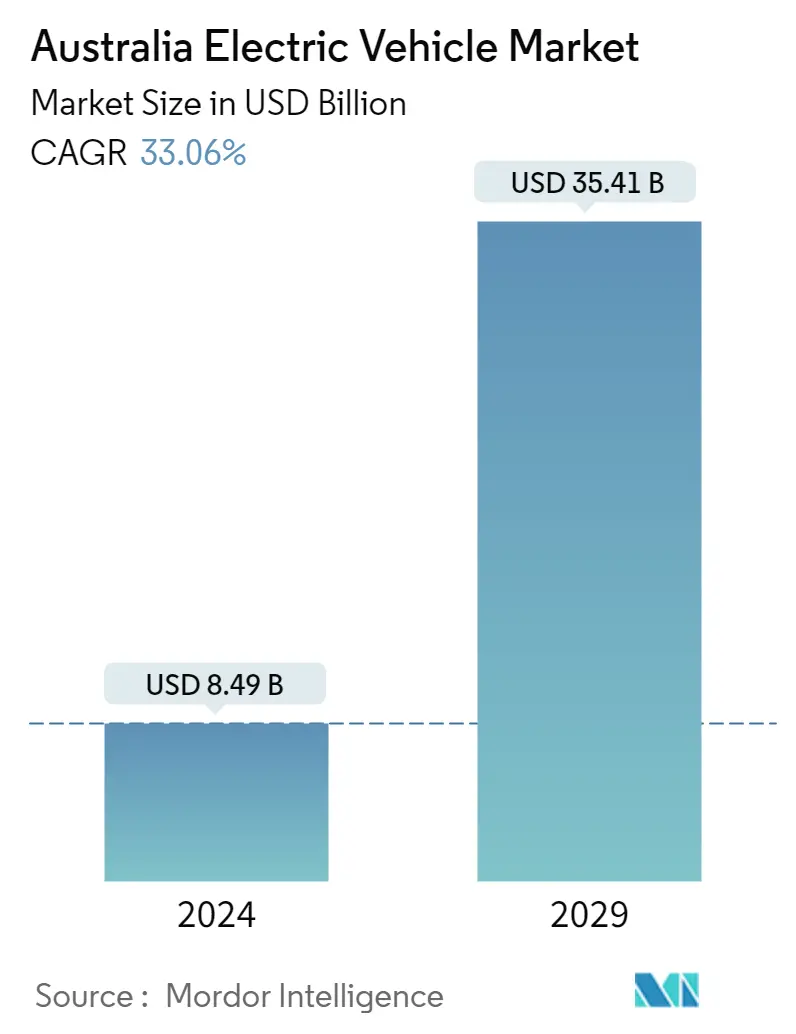
| Study Period | 2019 - 2029 |
| Base Year For Estimation | 2023 |
| Market Size (2024) | USD 8.49 Billion |
| Market Size (2029) | USD 35.41 Billion |
| CAGR (2024 - 2029) | 33.06 % |
| Market Concentration | Medium |
Major Players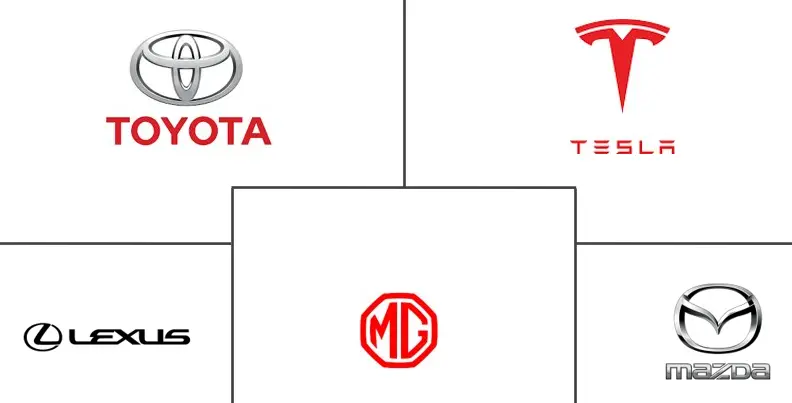
*Disclaimer: Major Players sorted in no particular order |
Australia EV Market Analysis
The Australia Electric Vehicle Market size is estimated at USD 8.49 billion in 2024, and is expected to reach USD 35.41 billion by 2029, growing at a CAGR of 33.06% during the forecast period (2024-2029).
- The COVID-19 pandemic initially had a negative impact on the market as the shutdown of manufacturing units and lockdowns resulted in a decrease in sales during the first half of 2020. However, eased restrictions coupled with notable initiatives of the government in the form of incentives and relief packages helped the market regain momentum by 2021. For instance, in Australia, 8,688 electric vehicles were sold in the first half of 2021.
- Despite the global coronavirus pandemic, electric car sales have proven unexpectedly resilient in comparison to overall new vehicle sales. Australia was one of the top Asia-Pacific countries in terms of electric car adoption, with a value of about three percent in 2021. Further, in 2022, 33,410 electric vehicles were sold in Australia, setting a new high.
- Over the medium term, increased demand for fuel-efficient, high-performance, and low-emission vehicles, increasingly strict laws and regulations on vehicle emissions, declining battery costs, etc., are expected to act as primary factors driving the market growth over the forecast period. Further, the active presence of key global players like Tesla, MG, and others with a focus on adopting strategies like offering cost-efficient models, product innovations, etc. expected to create a positive outlook for the market in the long run.
- For instance, in January 2023, Aptera announced that the Launch Edition of its hyper-efficient solar-powered battery electric vehicle would go into production in 2023. With its 700-watt solar cell technology, the patented solar technology can add up to 64 kilometers of range. The startup brand revealed in 2022 that the solar cells for its three-wheeler EV will be manufactured. These cells completely cover the car, including the top and all upward-facing surfaces.
- Government regulations to phase out fossil fuel-powered vehicles and government expenditures to improve public EV charging infrastructure are likely to contribute to market development. Further, Increasing investments and product launches by major OEMs in the country and their focus on localizing supply chain facilities create a positive outlook in the market.
- Despite being home to one of the world's most successful charger manufacturers, Tritium DCFC, Australia currently has less than a third of the number of public chargers for every EV on the road compared to the worldwide average.
- However, The NRMA, a motorist services company, is collaborating with the government to establish 135 charging stations across the national highway network over the next two to three years, adding to the 2,392 sites now in place. Moreover, the Australian government has also developed a national EV policy and increased financing for greener transport to AUD 500 million (USD 339 million). Electric vehicle sales in the country are already on the rise, accounting for 8% of total automobile sales in April 2023, up from 1.1% the previous year.
- New South Wales and Victoria are home to the majority of Australia's electric vehicles, followed by the South Australia region. These states play a key role in the growth of the Australian electric vehicle market, with the majority of demand being supported by government initiatives and supportive charging infrastructure.
Australia EV Market Trends
Hybrid Electric Vehicle Segment of Market Likely to Hold Significant Share in the Market
- Some of the major factors driving the growth of the market studied are the enactment of stringent emission and fuel economy norms and government incentives for promoting the purchase and adoption of hybrid vehicles. There has been tremendous growth in hybrid vehicles all over the country as these vehicles appeal to a much larger audience when compared to full-electric vehicles. They combine the reliability, long-range drivability, and instant refueling benefits of petrol and diesel vehicles with better fuel economy and a smaller carbon footprint of electric vehicles.
- For instance, in Australia, hybrid automobiles outsold electric vehicles by more than two to one in 2022. With almost 315,000 hybrids sold over the last 20 years, the emissions savings are comparable to putting 95,000 electric vehicles on the road. These cars, sometimes referred to as self-charging hybrids or HEVs, now make up 7% of all new passenger cars, SUVs, pickups, and vans sold in Australia. According to data from the Federal Chamber of Automotive Industries (FCAI), conventional, "self-charging" hybrid vehicles accounted for 89.2 percent of those electrified sales.
- Toyota's lineup of hybrid cars and SUVs accounts for 92.9 percent of those sales. The mid-size RAV4 SUV led the list with 25,850 sales, the Corolla with 14,657 units, and Camry with 10,979 units. In addition, Lexus, a luxury division of Toyota, set records for hybrid sales in 2021, with petrol-electric models making up 38.8% of the 9290 vehicles the company reported as sold.
- This is higher than the growth rates for conventional hybrids and electric vehicles, which were 12% and 127%, respectively. The 41,056 conventional hybrids delivered so far this year outsell the 2,941 plug-in hybrids sold so far. However, with a wide range of vehicles available for sale in Australia across 17 manufacturers and 30 model lines, plug-in hybrid sales are gaining momentum.
- Owing to the growing sales, the portfolio for electric vehicles of key OEMs is expanding, with many consumers preferring to go in for fully hybrid or mild hybrid vehicles across the country. For instance, in July 2022, Nissan announced the new Nissan X-Trail e-Power hybrid model will be available in Australian dealerships in 2023.
- In March 2022, Honda has confirmed plans to launch the next-generation HR-V in Australia. The new model will be available in two trim levels with a choice of petrol or hybrid power, pitting Honda against Toyota's C-HR hybrid and the upcoming Corolla cross hybrid.
- With governments taking stringent actions, in the form of regulations and incentives, along with the increased initiatives for the provision of public charging stations for electric vehicles, the hybrid electric vehicle segment of the market studied is expected to grow at a high rate during the forecast period.
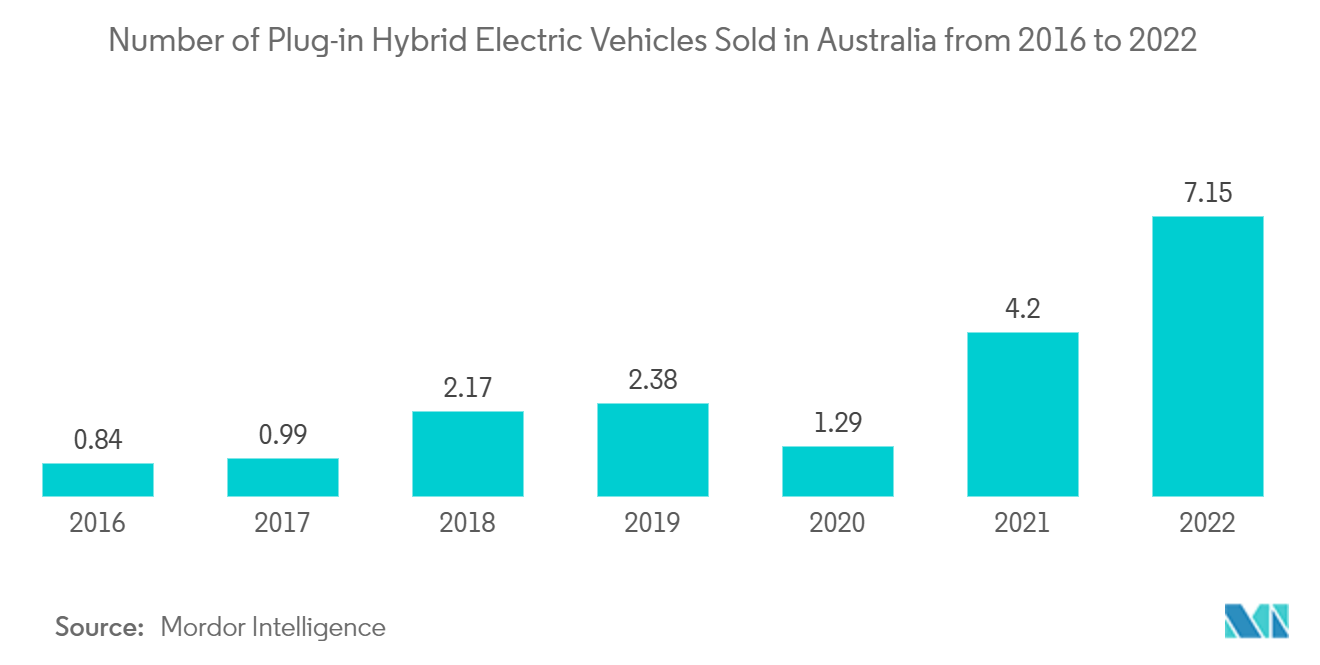
Growing Investments into Developing Charging Infrastructure in the Country
- The growth of electric vehicles (EVs) across the country is mainly supported by supportive charging infrastructure across the country. The massive investments in electric vehicles by major automotive companies, such as Toyota, Honda, Tesla, General Motors, and Ford, coupled with their EV charging strategies, propel demand in the market. The Australian government has been actively funding to improve the EV charging infrastructure across the country.
- For instance, in June 2022, to speed up the electric vehicle (EV) revolution across NSW, the government of New South Wales (NSW) announced an additional AUD 38 million (USD 27.74 million) in charging infrastructure approved as part of the 2022-23 NSW Budget. The extra financing brings the State's EV commitment under the NSW Electric Vehicle Strategy to AUD 633 million (USD 464 million).
- The financing will leverage large private sector investments to meet rising demand. It includes AUD 10 million (USD 7.5 million) to co-fund around 125 medium and large apartment buildings with more than 100 car parking spaces to upgrade their electrical systems to accommodate EV charging and AUD 10 million (USD 7.5 million) to co-fund 500 kerbside charge points to provide on-street charging in residential streets.
- In February 2022, The second round of the Australian government's Future Fuels Fund has begun, and the Australian Renewable Energy Agency (ARENA) will contribute AUD 127.9 million to co-finance charging infrastructure and H2 refueling stations to promote the use of battery and hydrogen vehicles in fleets. Several states have been actively pursuing fast-charging goals by creating strategies that suit their current EVs. Some of the state goals include,
- In May 2022, New South Wales made a significant stride towards becoming Australia's fastest State to purchase and operate an EV with an impressive AUD 131 million (USD 95.63 million) investment. This substantial funding is dedicated to creating the largest charging network in the region. Thanks to the NSW Electric Vehicle Strategy, the State will witness a substantial increase in the number of public fast-charging locations, rated at 50 kW or above, spread across the State.
- Further, in New South Wales, Australia, there were 556 electric car charging stations in 2022. The vast majority of them were conventional charging stations. The number of public electric car charging stations has increased significantly over the previous year thanks to ongoing investment. Various charging infrastructure initiatives have been undertaken by key players in the market to support the growing electric vehicle demand in the country.
- For instance, in April 2023, the Australian federal government announced that it is assisting companies in lowering the upfront expenses of converting to electric cars by allocating USD 6.2 million to a program with Origin Energy that will make 1,000 electric vehicles available to its corporate customers. Origin Energy will supply 1,000 electric cars and charging infrastructure to their corporate clients across Australia as part of the 'Accelerate EV Fleet' campaign. This statement came shortly after the unveiling of Australia's first National Electric Vehicle Strategy and promised to invest USD 70 million in charging infrastructure grant money.
- Such developments and instances are anticipated to contribute significantly to overall demand in the market during the forecast period.
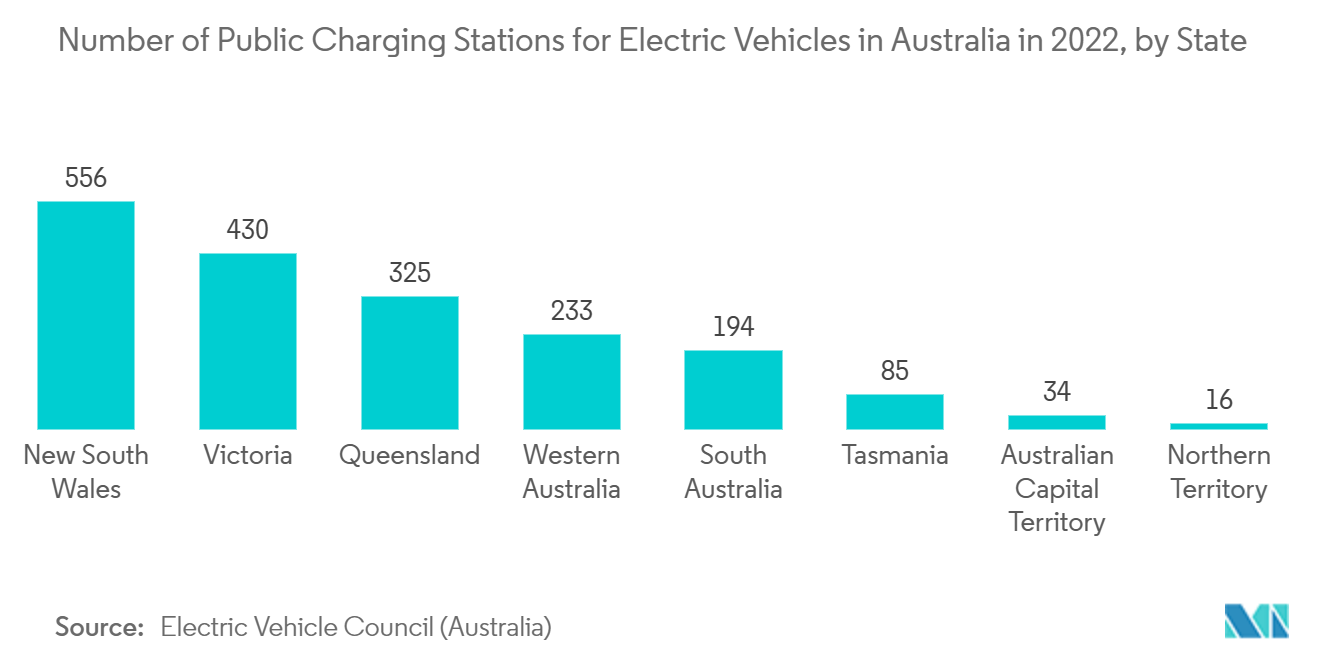
Australia EV Industry Overview
The Australian electric vehicle market is moderately consolidated owing to its competitive nature and the presence of a large number of players operating it across the country. These players are estimated to focus on the development of new products and innovations, which will help them expand their product portfolio and attract a large number of consumers across the country.
For instance, in August 2022, Toyota Australia announced pricing for the all-new Corolla Cross small SUV, which arrives in local showrooms in October with an entry-level recommended retail price of AUD 33,000. Customers will be offered a lineup of eight different variants with a choice of two-wheel drive or electric all-wheel drive, gasoline, or hybrid powertrains, and three grades - GX, GXL, and flagship Atmos.
In March 2022, Honda has confirmed plans to launch the next-generation HR-V in Australia. The new model will be available in two trim levels with a choice of petrol or hybrid power, pitting Honda against Toyota's C-HR Hybrid and the upcoming Corolla Cross Hybrid.
In October 2021, Ford Australia announced that it will introduce at least five new electrified vehicles by the end of 2024, starting with a full-size, pure-electric E-Transit as a part of its electrification strategy. E-Transit features both AC charging and DC fast charging. The vehicle's 11.3 kW on-board charger is capable of delivering a 100 percent charge in up to 8.2 hours. Ford Australia's EV roadmap forms part of Ford's global investment of USD 30 billion in electrification by 2025..p[
Some of the Key players operating in the Australian electric vehicle include Toyota Motor Corporation, Tesla, Lexus Corporation, Honda Motor Corporation, and others.
Australia EV Market Leaders
-
Toyota Motor Corporation
-
Tesla Inc.
-
Lexus Motor Corporation
-
MG Motor (SAIC MOTOR AUSTRALIA PTY LTD )
-
Mazda Motor Corporation
*Disclaimer: Major Players sorted in no particular order
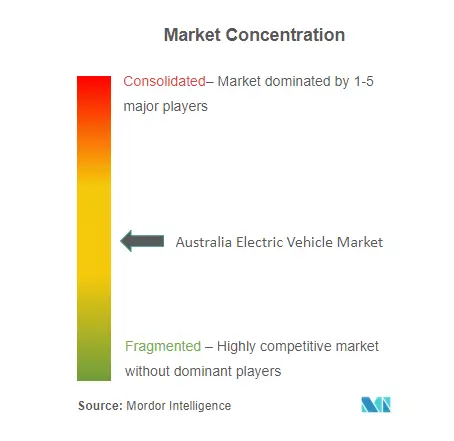
Australia EV Market News
- April 2022: SEAT announced that CUPRA's first fully electric model CUPRA Born will go into production for Australia by the end of 2022 and will start deliveries early in 2023. 2022 will also see the automotive brand open a CUPRA City Garage in Sydney's CBD. The unique destination, close to the world's most famous harbor, will offer an unconventional and unique customer experience.
- March 2022: BYD Atto launched its three electric crossovers in Australia through the exclusive distributor EV Direct. Among them is the Atto 3, which is known as the Yuan Plus in China. This cutting-edge model is built on e-Platform 3.0 and incorporates BYD's advanced Blade EV battery technology. The Atto 3 is available in two energy capacities, with the standard variant (Superior) equipped with a 50.1-kWh pack that provides a WLTP range of 320 km. For those seeking an extended range, the Superior Extended Range variant comes with a 60.4-kWh unit capable of covering 420 km on a single charge.
- February 2022: Polestar announced the start of sales in Australia, with deliveries of the Polestar 2 set to begin in March with pre-configured vehicles. Polestar 2 is the first fully electric model in the Polestar portfolio, with pricing starting at a highly competitive USD 59,900 for the Standard range Single motor and USD 64,900 for the Long-range Single motor.
- February 2022: Hyzon Motors Inc. announced that Melbourne will be home to Hyzon Motors Australia's headquarters under a new partnership agreement between the RACV and Hyzon, a global leader in zero-emissions hydrogen-powered commercial vehicles. Hyzon Motors, in conjunction with the RACV at their Noble Park location, will develop a purpose-built facility including corporate offices, a showroom, assembly warehousing, and a workshop, expected to generate over 100 local engineering and manufacturing jobs by 2025.
Australia EV Market Report - Table of Contents
1. INTRODUCTION
- 1.1 Study Assumptions
- 1.2 Scope of the Study
2. RESEARCH METHODOLOGY
3. EXECUTIVE SUMMARY
4. MARKET DYNAMICS
-
4.1 Market Drivers
- 4.1.1 Growing Investments into Developing Charging Infrastructure in the Country
-
4.2 Market Restraints
- 4.2.1 Lack of Public Charging Station
-
4.3 Industry Attractiveness - Porter's Five Forces Analysis
- 4.3.1 Threat of New Entrants
- 4.3.2 Bargaining Power of Buyers/Consumers
- 4.3.3 Bargaining Power of Suppliers
- 4.3.4 Threat of Substitute Products
- 4.3.5 Intensity of Competitive Rivalry
5. MARKET SEGMENTATION (Market Size in Value - USD billion)
-
5.1 By Propulsion Type
- 5.1.1 Battery Electric Vehicles
- 5.1.2 Hybrid Electric Vehicles
- 5.1.3 Fuel Cell Electric Vehicles
- 5.1.4 Plug-In Hybrid Electric Vehicles
-
5.2 By Vehicle Type
- 5.2.1 Passenger Cars
- 5.2.2 Light Commercial Vehicles
- 5.2.3 Medium-Duty Commercial Vehicles
- 5.2.4 Heavy-Duty Commercial Vehicles
6. COMPETITIVE LANDSCAPE
- 6.1 Vendor Market Share
-
6.2 Company Profiles
- 6.2.1 Toyota Motor Corporation
- 6.2.2 Tesla Motors Inc
- 6.2.3 Lexus Motor Corporation
- 6.2.4 MG Motor (SAIC MOTOR AUSTRALIA PTY LTD )
- 6.2.5 Mazda Motor Corporation
- 6.2.6 Hyundai Motor Group
- 6.2.7 BMW Group
- 6.2.8 Volkswagen AG
- 6.2.9 Jaguar Land Rover Automotive PLC (Tata Motors)
- 6.2.10 BYD Co. Ltd
- 6.2.11 Honda Motor Company Ltd
- 6.2.12 Renault Group
- 6.2.13 Mercedes-benz Group AG
- *List Not Exhaustive
7. MARKET OPPORTUNITIES AND FUTURE TRENDS
** Subject To AvailablityAustralia EV Industry Segmentation
An electric vehicle operates on an electric motor instead of an internal combustion engine, which solely generates power by burning a mix of fuel and gases. Therefore, an electric vehicle is seen as a possible replacement for the current-generation automobile in the near future to address environmental challenges.
The Australian electric vehicle market is segmented by propulsion type (battery electric vehicles, hybrid electric vehicles, fuel cell electric vehicles, and plug-in hybrid electric vehicles) and by vehicle type (passenger cars, light commercial vehicles, medium-duty commercial vehicles, and heavy-duty commercial vehicles).
The report offers the market size and value in (USD) for all the above segments.
| By Propulsion Type | Battery Electric Vehicles |
| Hybrid Electric Vehicles | |
| Fuel Cell Electric Vehicles | |
| Plug-In Hybrid Electric Vehicles | |
| By Vehicle Type | Passenger Cars |
| Light Commercial Vehicles | |
| Medium-Duty Commercial Vehicles | |
| Heavy-Duty Commercial Vehicles |
Australia EV Market Research FAQs
How big is the Australia Electric Vehicle Market?
The Australia Electric Vehicle Market size is expected to reach USD 8.49 billion in 2024 and grow at a CAGR of 33.06% to reach USD 35.41 billion by 2029.
What is the current Australia Electric Vehicle Market size?
In 2024, the Australia Electric Vehicle Market size is expected to reach USD 8.49 billion.
Who are the key players in Australia Electric Vehicle Market?
Toyota Motor Corporation, Tesla Inc., Lexus Motor Corporation, MG Motor (SAIC MOTOR AUSTRALIA PTY LTD ) and Mazda Motor Corporation are the major companies operating in the Australia Electric Vehicle Market.
What years does this Australia Electric Vehicle Market cover, and what was the market size in 2023?
In 2023, the Australia Electric Vehicle Market size was estimated at USD 6.38 billion. The report covers the Australia Electric Vehicle Market historical market size for years: 2019, 2020, 2021, 2022 and 2023. The report also forecasts the Australia Electric Vehicle Market size for years: 2024, 2025, 2026, 2027, 2028 and 2029.
Australia EV Industry Report
The Australian Electric Vehicle Market is undergoing significant transformation, driven by various factors including advancements in propulsion types such as battery electric vehicles, hybrid electric vehicles, fuel cell electric vehicles, and plug-in hybrid electric vehicles. The market is segmented by vehicle types, encompassing passenger cars, light commercial vehicles, medium-duty commercial vehicles, and heavy-duty commercial vehicles. The market share and market size of electric vehicles in Australia are key indicators of the industry's growth trajectory.
Industry analysis reveals a positive market outlook, with industry statistics showing a steady increase in market value. Market growth is supported by favorable market trends and market segmentation that cater to diverse consumer needs. Industry reports and market reports provide comprehensive market data and market forecast, highlighting the industry's potential for future expansion.
Market leaders are playing a crucial role in shaping the market landscape, with their strategic initiatives and innovations. The industry overview and market overview offer insights into the current state of the market, while the market review and market predictions provide a glimpse into the future.
Research companies are actively involved in industry research, contributing to a deeper understanding of market dynamics. The industry size and market value are expected to witness substantial growth, driven by increasing consumer demand and technological advancements.
The report pdf and report example provide detailed industry information, including market statistics, industry trends, and growth rate. The industry outlook remains optimistic, with industry sales projected to rise. The market forecast and growth forecast indicate a robust market growth, supported by strong market data and industry analysis.
In conclusion, the Australian Electric Vehicle Market is poised for significant growth, with market predictions and market segmentation highlighting the diverse opportunities within the industry. The market outlook and industry outlook suggest a promising future, driven by continuous innovation and strategic market initiatives.



